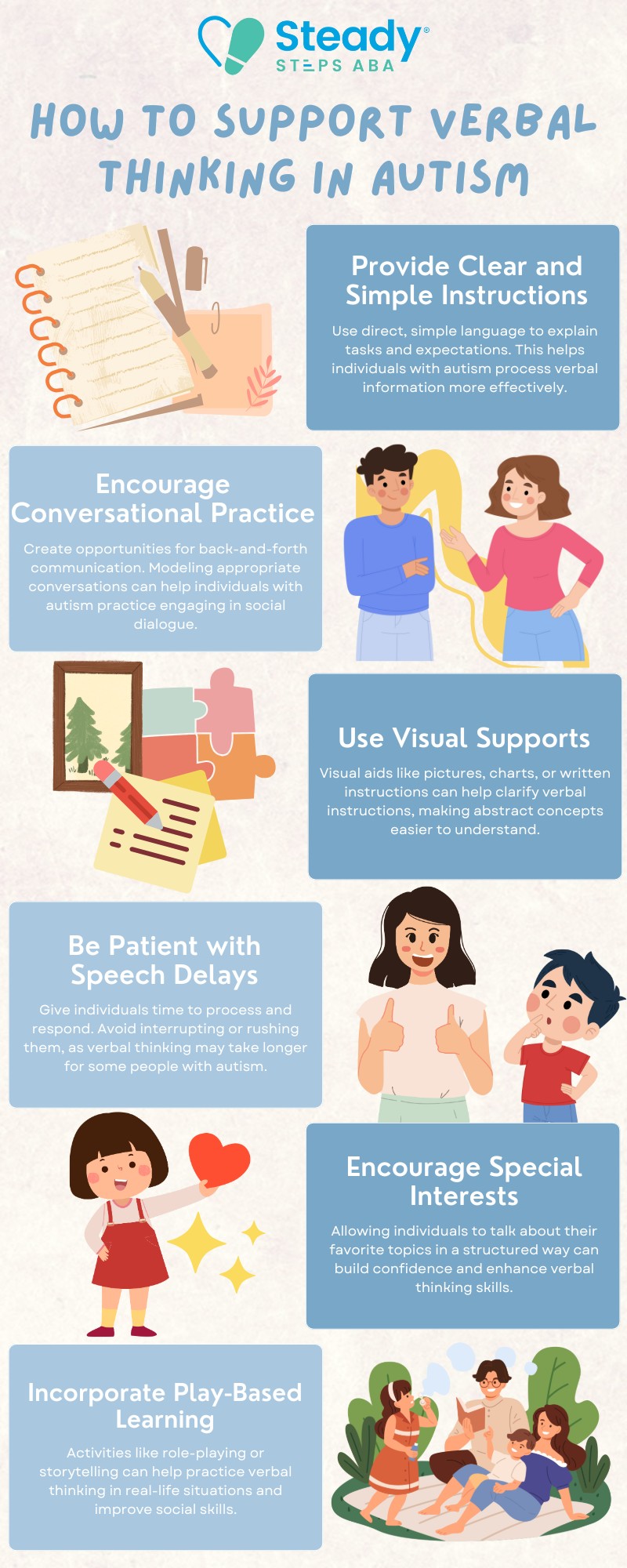Key Points:
- Verbal thinking in autism involves using language to guide thoughts, process experiences, and solve problems.
- Individuals with autism may show varying levels of verbal thinking ability.
- There are different types of verbal thinking in autism, each with unique traits that can affect communication and learning.
Autism impacts various aspects of life, especially communication and thought processing. One key area often overlooked is verbal thinking — how those with autism use language to make sense of the world around them. By understanding verbal thinking in autism, parents, caregivers, and educators can provide more effective support, helping children navigate daily life and communicate their needs more confidently.
What is Verbal Thinking in Autism?
Verbal thinking in autism refers to how individuals use language to process thoughts, solve problems, and understand the world around them. It’s how people connect their inner thoughts with the outer world through words. While verbal thinking is a crucial part of cognitive development, people with autism may experience it differently.
For example, some individuals with autism may struggle to organize their thoughts in a way that makes sense to others. Others may excel in using verbal thinking to express themselves but have difficulty with social communication.
Types of Verbal Thinking Issues in Autism
Verbal thinking issues in autism can take different forms, each with its own set of traits. Let’s take a look at the most common types:
Echolalia
Echolalia refers to the repetition of words or phrases that others have said, often without understanding their meaning. This type of verbal thinking is seen in some individuals with autism, and it can manifest in various ways. For example, a person might repeat phrases from TV shows, conversations, or other sources without applying them to the current situation.
Echolalia often serves as a coping mechanism. For individuals with autism, it can help process language or provide comfort. It may also act as a way to engage with the environment, even if the phrases repeated don’t have direct relevance to the moment.
Literal Thinking
Literal thinking involves interpreting language at face value, without recognizing abstract concepts, idioms, or figurative speech. Individuals who experience literal thinking may struggle with phrases or expressions like “break a leg,” as they tend to interpret such statements literally rather than understanding the implied meaning.
This type of thinking is common in individuals with autism, who may have difficulty grasping the nuanced or non-literal aspects of language. Literal thinking can lead to confusion in social interactions where indirect language or humor is often used.
Monologue Speech
Monologue speech refers to a person talking to themselves, often about a specific topic or interest, without engaging others in the conversation. This speech pattern typically manifests when an individual is focused on a subject they are passionate about, but they may not initiate or encourage a back-and-forth exchange.
In individuals with autism, monologue speech often arises from a deep focus on a particular area of interest. While it allows the person to express their thoughts, it may limit social interaction and make it challenging for them to connect with others in conversation.
Delayed Speech
Delayed speech refers to a delay in the ability to use verbal language for communication, which can impact how verbal thinking is organized. Children with autism who experience delayed speech may not start speaking at the expected age or may use fewer words compared to their peers.
Speech delays are common among children with autism, and they can affect how language is used to structure thoughts. These delays might result in difficulty expressing oneself clearly, but with the right support, individuals can improve their communication skills over time.

Traits of Verbal Thinking in Autism
Understanding the traits associated with verbal thinking in autism can help identify the strengths and challenges faced by individuals. Below are some key traits to look out for:
- Difficulty with Abstract Language: People with autism often struggle with abstract or complex language concepts like metaphors, analogies, or humor. They may understand the basic meanings of words but miss the intended nuance.
- Repetitive Patterns of Speech: Verbal thinking in autism can lead to repetitive speech patterns, especially when discussing special interests or favorite topics. While this can be a sign of deep knowledge, it can make communication with others challenging.
- Limited Social Communication: Individuals with autism may have trouble using verbal thinking in social contexts, such as understanding when it’s their turn to speak or responding appropriately to conversational cues. This can affect how they interact with others in group settings.
- Difficulty with Organizing Thoughts Verbally: Some individuals may find it hard to express their thoughts clearly using words, leading to long pauses, stuttering, or mixed-up sentences. This can impact their ability to engage in structured conversation.
- Preference for Structure: Verbal thinking in autism often thrives when there’s a clear structure. People may be more comfortable using language when it follows predictable patterns or routines.
Supporting verbal thinking in autism involves strategies that promote clear communication and cognitive development. These strategies can be applied at home, school, or therapy sessions. Here are a few ways to encourage and support verbal thinking:

Partner with Steady Steps ABA
Understanding verbal thinking in autism is essential for providing the right support and fostering effective communication. With tailored approaches and evidence-based strategies, individuals with autism can enhance their verbal thinking skills, leading to better communication and social interactions.
If you’re seeking professional support to help your child improve verbal thinking and communication skills, Steady Steps ABA is here to assist. Our dedicated team provides personalized ABA therapy designed to address each child’s unique needs, promoting positive growth and communication.
Contact us today to learn more about how our ABA therapy services in Maryland can make a meaningful difference in your child’s development.






